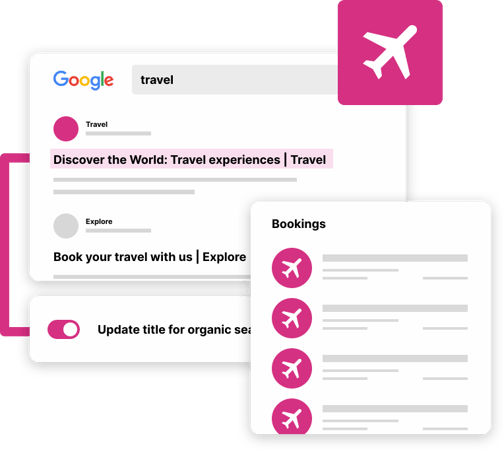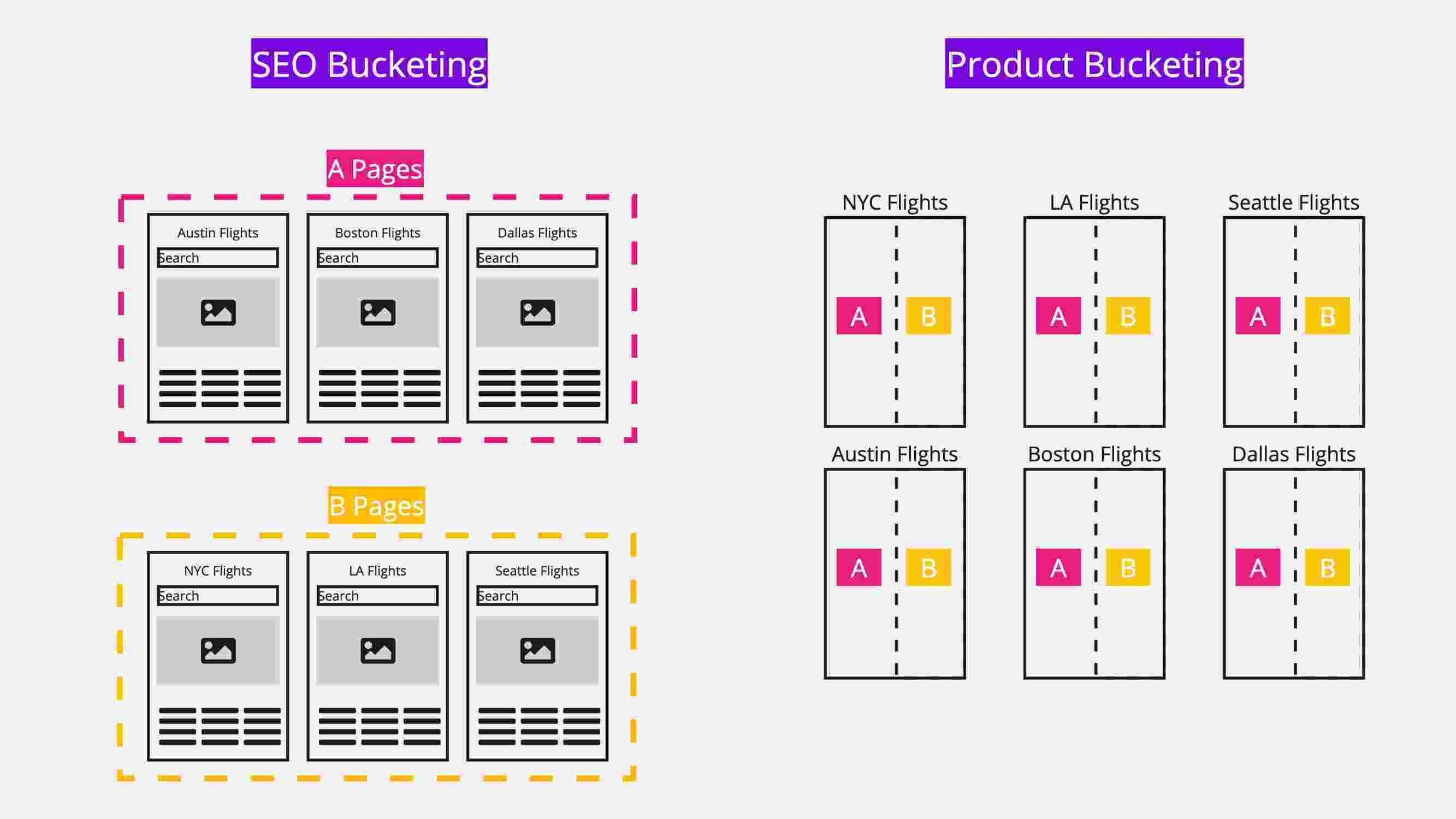Fifty-five percent of travelers say they have to check too many travel information sources before they can make a decision, according to Google research. Unlike other purchases, planning holidays can be a costly and stressful task.
To make the ordeal easier, your customers need clear, readily available travel information at their fingertips. And, naturally, you want them to find this information on your website — not your competitors’.
This requires careful Search Engine Optimization (SEO) to boost your rankings, visibility, and organic sessions. To win at the SEO game, however, you need to implement data-driven SEO tests — and we’re going to show you why.
SEO A/B testing splits pages instead of users. You make rules-based changes to a group of pages across your site, and compare the performance of the pages you changed to those that stayed the same. This shows you the impact of any changes while also accounting for seasonality — obviously a big deal in the travel industry.
This gives you valuable, actionable SEO impact data — both positive and negative. From here, you can make informed changes to your website that’ll:
- Boost organic traffic
- Drive confidence in your website changes
- Improve accountability
- Enhance visitor navigation and information architecture
- Generate more revenue
These tests are essential for not only gaining an edge over your market competitors, but giving your customers the travel experience they’re searching for.
All this being said, SEO testing can be a complex and time-consuming process. It’s often unclear where to start and how to truly measure the impact of your changes. So, to help you along, we'll delve into the essentials of SEO testing and provide 18 travel-specific test ideas to get you on the right track.
Follow these SEO testing best practices
Before we dive into our essential tests, let’s run through some best practice steps that’ll help you make the most of your SEO testing:
- Optimal sample size. SEO testing yields robust results on websites with a large number of pages. We recommend a minimum of 1,000 organic sessions per day. This ensures a solid sample size for accurate evaluation.
- Identify comparable pages. Focus on pages that use the same template. Split them in two and create a variant group (the group you’ll make changes to) and a control group (which you’ll keep the same).
- Formulate a hypothesis. Create a hypothesis that you believe will increase your traffic, such as, “We predict that moving content higher up the page will improve SERP rankings.”
- Test rigorously. Implement changes to the variant group while keeping the control group unchanged.
- Measure results. Analyze the outcome of the SEO test and determine whether the changes had a positive or negative effect on organic traffic. Of course, statistical analysis can be complex, and you’ll need to account for seasonality and other influences. It’s also important to note that negative results are just as important to your SEO testing efforts as positive results.
- Make informed decisions. Roll out changes to all relevant pages or revert to the control group if it outperformed the variant.
Now you know the best practices, let’s run through our list of travel-specific SEO tests.
18 travel SEO test ideas to boost your traffic
So that you can easily work through our list, we’ve broken down our ideas into four key categories. You’ll find some “quick win” options as well as some more in-depth changes. Remember that all of these changes can potentially result in neutral or negative outcomes — which is why it’s essential to test them first.
Metadata - quick and simple changes
1. Titles: enhance titles by adding price, brand, or month/year information. This is particularly relevant for travel SEO where searchers are always looking for specific prices and dates.
2. Meta description: add destination details, baggage information, and trust language (such as “payment security”, and “book with confidence”).
Internal linking - enhance navigation structure
3. Show breadcrumbs: display the path to and from pages instead of hiding them in drop-down menus. Google prefers websites with clearer website navigation visibility — as do your customers.
4. Add specificity to breadcrumbs: expand breadcrumbs to include additional levels of categorization. For example: “Holidays > Spain > Benidorm” becomes “Holidays > Europe > Spain > Costa Blanca > Benidorm.”
5. Improve breadcrumb anchor text: add relevant keywords (such as “holidays”) for better SEO visibility. For example: instead of “Destinations > Spain > Costa Blanca > Benidorm,” we now have “Destinations > Benidorm Holidays.”
6. Increase internal linking: connect more pages together, focusing on specific destinations or travel topics.
7. Create a popular links footer: showcase popular destinations in your footer. This provides additional authority signals to search engines and can aid your visitors with their search.
Content - maximize visibility and user experience
8. Bring content out of dropdown menus and tabs: make important content (such as FAQs) readily visible to users without the need for additional clicks. Google rewards visible content that requires minimum user effort.
9. Show content by default: display content in its entirety without requiring users to take action, such as clicking a "read more" button.
10. Optimize content length: analyze the impact of long content on different pages. For example, transactional or checkout pages have a clear function and don’t require overwhelming information.
11. Add travel information: add practical travel details to pages. This includes destination language, currency, and travel time. This is a way to add searched-for keywords to your most valuable pages.
12. Optimize your “about the weather” section: answer weather-related questions that users want to know. We’d recommend listing the hottest and coldest months.
13. Add expertise, authority, and trust: highlight useful transactional information. This includes payment options, insurance, and other trust indicators. Google prioritizes websites that demonstrate trustworthiness.
14. Include a “book with confidence" section: dedicate a section to the booking process. This emphasizes security and trust.
15. Demonstrate up-to-date information: add an “updated xx/xx/xxxx” line to pages. This is particularly useful for exchange rates, travel times, and weather. It demonstrates freshness and reliability to both users and search engines.
16. Add company reviews: showcase customer reviews and social proof to build trust and enhance conversion rates.
Structured data - leverage schema markup
17. Re-test FAQ schema: ensure you properly markup your FAQs to get them recognized by search engines.
18. Try the Blemish Theory: this is the idea that a small piece of negative information adds credibility, believability, and authenticity. Consider saying who a destination is not for, alongside saying who it is for.
Next steps: optimizing your travel SEO efforts
You want your website to be the first port of call for travelers. More than this, you want your visitors to receive a clear, informative, and trustworthy experience when navigating your website.
SEO tests allow you to make informed changes that improve your organic traffic and your customer experience. Of course, implementing these tests at scale — particularly for large travel websites — requires the right data-driven tools. That’s where SearchPilot can offer support.
Our SEO A/B testing platform allows you to conduct tests, measure their impact, and push impactful changes at speed. And the results speak for themselves; we recently won the award for Best Use of Data (SEO) for our work with Skyscanner at the European Search Awards 2023.
By running over 1,000 SEO A/B tests, we helped Skyscanner achieve a staggering 27 percent growth on their pre-COVID traffic levels. Now imagine what you could achieve.
This article is based on one of our webinars on Travel Site SEO. For more in-depth information on the above, you can watch it here. Or, if you’d like to learn more about SearchPilot and our platform, contact us today for a full demo.




![[Webinar Replay] What digital retail marketers should DO about AI right now](https://www.searchpilot.com/hubfs/what-to-do-about-ai-thumbnail.png)